As much as I’d like to completely immerse myself in the goldwork embroidery project that I started last week (when I laced up the frame I told you about on Monday), the fact is, there’s still quite a bit to do to prepare for the kids’ embroidery classes coming up in July.
In the back of my mind, this floral corner embroidery design for the flour sack towel project has been nagging me. I wanted to whittle it down a bit, so that it wasn’t quite as busy. While I like the version I showed you in the link above, it is a bit much for younger kids.
There’s just too much going on in the design! And it would take too long for the younger classes to complete it – even though the projects are meant to be taken home and worked on away from class time.
To settle the problem, I quickly worked up a Lite Version of the floral corner design and then hastened to stitch it. You can see both versions in the photo below.
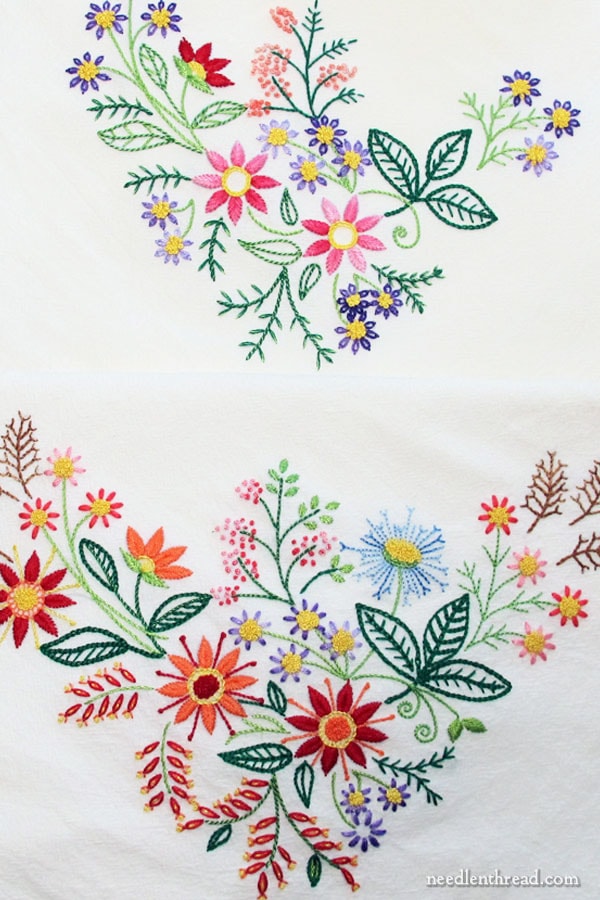
The top version is the lite version.
It incorporates the same basic stitches the kids will be learning, but on a much lighter scale. And while it’s certainly less balanced, I like the non-symmetrical look of it. With both designs, I tried to avoid too much symmetry.
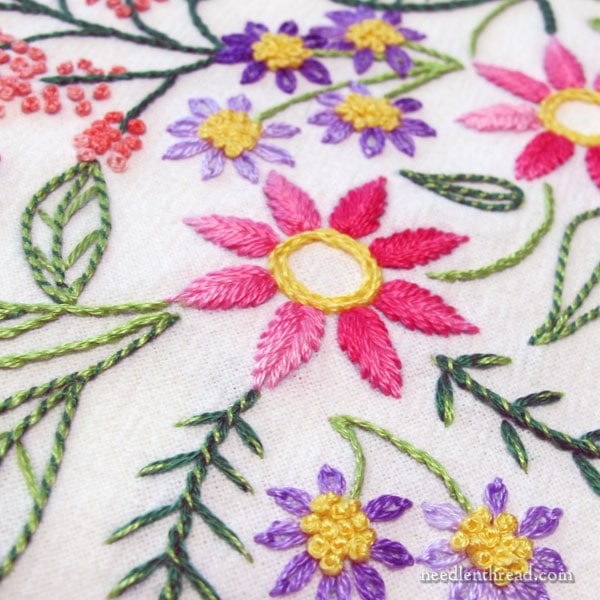
Backstitch, whipped backstitch, chain stitch, stem stitch, daisy stitch, French knots – they’re all pretty basic. The most advanced stitches we’ll be tackling are the French knot and the fishbone stitch.
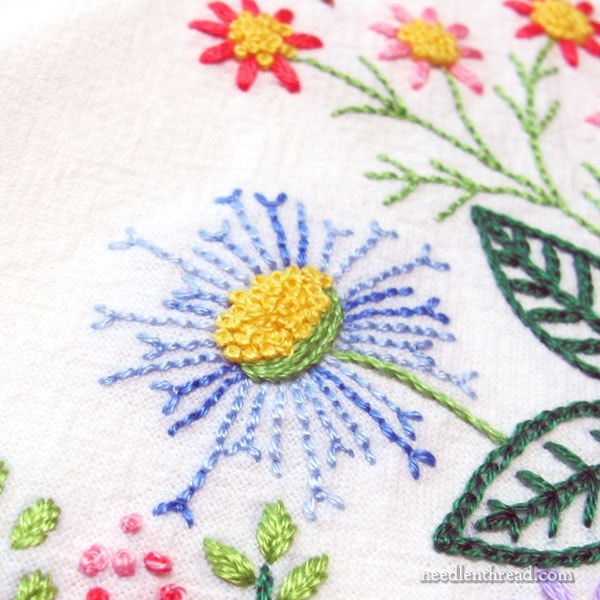
This flower has been completely cut from the design, even though it incorporates only backstitch, stem stitch, and French knots. It’s the scope of the flower that’s the problem. That’s a lot of backstitch (and a lot of French knots).
I’ve had varying results, teaching French knots to children, by the way. Since some of you sent in feedback suggesting that French knots are too advanced for little kids, I thought I’d mention this point. I’ve had little children (6 & 7 year olds) pick up the French knot without a problem, and I’ve had little kids and older kids struggle with the French knot, too.
In my experience, the main source of the struggle with French knots for children has always been the problem of speed. Kids are generally in a huge hurry to see a result, to finish a stitch, and so the notion of pulling the thread through slowly takes a little getting used to.
But, in the end, I haven’t taught a kid yet who didn’t eventually “get it.” So I’m not too worried about the French knots. And if there are kids who struggle with them too much, we can always make easier substitutions.
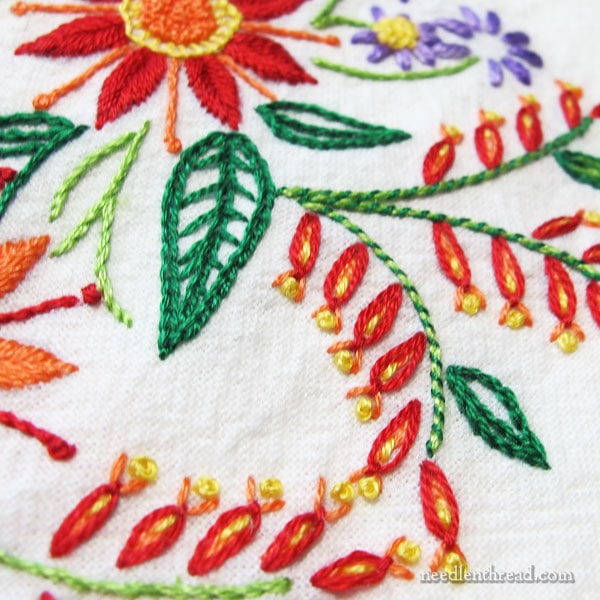
I snipped these flowers out in the Lite Version of the design, too. Again, not because they’re exceptionally difficult, but because there are just so many of them!
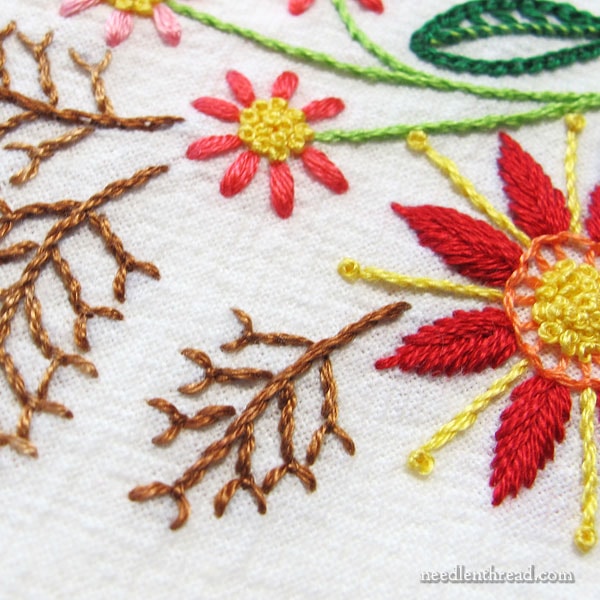
The twiggy bits have also been cut away, and the larger flowers have been simplified considerably.
I got rid of the buttonhole wheel centers in the larger flowers because they’re a difficult element to get right. The flowers aren’t filled with French knots, either. The lines between the petals are gone, too. So the large flowers are much simpler and, I think, a lot cleaner looking.
The Lite Version of the towel will be the second project for the younger kids, so by the time they get to it, they will have worked on their own little sampler / doodle cloth to learn the stitches, and they will have applied the stitches they’ve learned in a small, simpler project which I’ll show you next week. (It’s pretty sweet!)
The floral corner designs will show up here on the website once the classes are in progress. That way, if you want to stitch along, you’re most welcome to do so!
Any questions, comments, or suggestions? Feel free to chime in below!




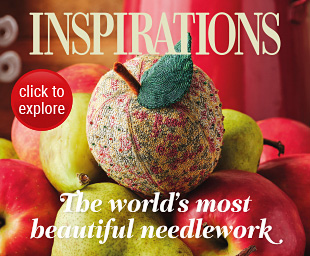
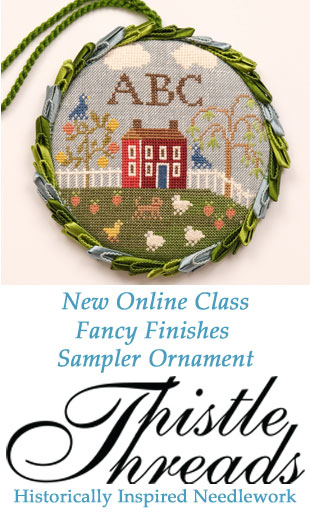
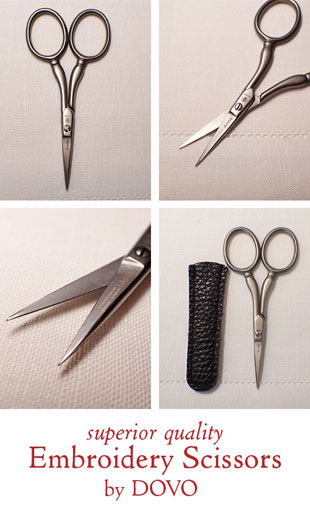
I like the lite version tremendously – it’s clean, it’s cheerful, it has still got all the stitch elements in it that you want them to practice; perfect!
Having said that, I like the teeny weeny orange/red flowers; are they a combination of lazy daisies?
I like those little ones, too! But there are loads of ’em! Yes, they start with a foundation of detached chain and then go overboard from there! 🙂
Where do you buy top quality tea towels suitable for embroidery?
I would love to know too
These flour sack towels are from ACS Home & Work. They’re the “deluxe” heavier weight flour sack towels. I used to LOVE these towels and they were always my go-to flour sack towel. They’ve changed them a bit in the last several (maybe five?) years. The weave is not as tight as it used to be, the towels aren’t as smooth, and they are not white. They’re definitely off-white. On their own, they look white enough, but if you put them next to anything white, they look more cream than white. Still, they’re a decent quality towel, especially compared to the ones you’d pick up at craft stores or Walmart or similar places. I’ll write a little more about flour sack toweling and sources in the near future, since I’ve had quite a few inquiries.
As soon as I saw this it brought back wonderful memories of my Grandmother Smith teaching me to embroidery when I was a little girl! I remember sitting on the Davenport and her patiently teaching me the French knot. It was difficult at first but I got it:) I think it’s a perfect thing for children to learn – we all need to slow our roll a bit! Thank you for sharing.
My five year old grand daughter who decided to embroider Mary’s Sampler took on the french knots with no trouble at all. She said she wanted to embroider it because it is so beautiful.
I am so happy you are doing this for the children. I took crewel embroidery classes about 50 years ago in a tiny craft shop, in my small hometown in Connecticut. I still remember that fondly. I was the only girl in class so I got lots of personal attention. Those classes have given me a life long appreciation for the needle arts.
Love the lite version!
The light version is very pretty, but it still has a lot of knots – they’re in the pink spray along the diagonal as well as the yellow centres to the purple daisies. What would it look like with the pink knots removed and just the foliage instead? (I like knots – don’t get me wrong! Just wondering if the yellow centres would be enough knots for the students.) I think you are wise to avoid making the designs highly symmetrical.
Hi,Elaine – yes, it’s a few knots, but Knot as many! I don’t want to eliminate them altogether. When using three strands, the areas fill up pretty quickly.
I still can’t get the French knot! Is there any room in your class for a (really!) big kid!
🙂 Have you tried my video for French knots? The key is slow and keeping tension on the thread as you pull through.
A delightful kitchen brightener in either form! Looks to be pure fun to stitch…
Linda
It looks like a fun project, Mary! I love that if any of your students excel and want to do more, they could add back some of the elements that you’ve taken out. I sure hope you get at least one budding enthusiast!
I don’t ‘facebook’ so may have missed it… how many kids are you planning to teach in your class next month?
32 spread across six classes.
I like the lite version too! If I’m being a naggy picky nitpicker, I would say that I’d like to see those three leaves on the right in medium rather than dark green now that some of the original balancing motifs have been removed/lightened.
I was going to whip stitch those with the light green, to lighten it a bit. It will lighten it up a bit!
Your video’s and your blogs work for me…. senior person learning a beautiful art!! Your teaching methods are awesome! Thanks for sharing that talent!
Thanks, Danni! I’m glad you find them helpful! 🙂
Hi Mary,
When I taught stitching to children, they liked to put words in their art, especially their name. My friend Winky Cherry wrote several books to teach children to sew and embroider. It is an entire teaching system for people to teach children how to sew wool felt animals and then how to embroider and on to making a quilt using a sewing machine. It helped me tremendously in the areas of teaching I had no background for. You can order from the publisher Palmer Pletsch. I taught 15 children to sew felt animals and embellish with embroidery. It was quite rewarding.
Very hard work but Winky’s books helped. It was great that she lives close by and could couch me! As soon as the children had the basics, they took off and started creating their own designs. Have fun Mary. You will know right away if your design is too hard or too easy. I would test it out with one child first to see how it goes before you launch the class.
Hi, Robin – Oh, yes, I’ve tested it already. It’ll work. I’ve taught loads of youth embroidery classes. I used to do it in the summer, between teaching full time academic courses during the school year, and it was always a fun break from the “serious” subjects of school. It’s fun to be around kids during the summer, when they’re more relaxed and there aren’t the same schoolish expectations!
Good morning Mary
Some time ago I read on the internet a trick to making good French knots. It has worked very well for me.
After you have tightened the thread around the needle and just before you pull the needle through the fabric, turn the needle a bit counter clockwise.
As I said, it does work for me.
The lite version I do like.
Sharon
The young people are going to have such a pretty project to show when their embroidery is complete. It’s impressive how you simplified without diluting the appeal of the embroidery.
Sometimes a seed stitch – the variety where one does one backstitch on top of the other – can substitute for a French knot. With adults who don’t like French knots, #11 seed beads are a pretty substitute.
I’d love to do the lite version on a towel for me! Beautiful design. Will it be available after your classes are done?
Yes, it will be available a little later in July, once the classes are underway!
Hi Mary!
I have my trouble with french knots, too. I’ve resorted to using colonial knots (I think – the figure 8 ones), especially with needle painting and those tiny single threads. Maybe it would be good to give the kids that as a backup? With French knots I always end up having to make a bunch of them many times over…;-)
Colonial knots are always a good substitute for French knots, and a great fall-back plan in case the French knots are harder to master. I find the French knot the easier of the two to teach, and most kids will get the French knot before they get the colonial knot, but it’s good to have both in the arsenal!
Sweetness!
I love your “lite version,” as something I’d like to stitch myself, as an adult “beginner” in needlework!! And, the backstitch flower, with the French knot center, is just brilliant in its simplicity and impact! It could stand alone, or with little else, as a beautiful motif.
Thanks, Mary Elizabeth! Yes, the whole design is actually made up of separate elements that I’d drawn for a collection of foliage and florals. So each type of element should be able to work alone to a degree. I’m so glad you noticed that! 🙂
I like the second version for the children. I agree with your thoughts, don’t want it to difficult, or too much to do. I like the new version very much. Good idea!
What about switching out the French knots for colonial knots? Even as an adult, I find I get much better results with the latter.
I’ve been thinking, the floral design for your children’s course would be wonderful worked up as another self-paced course/project for sale on your website, for “adult beginners” who are looking for a starting point for exploring needlework. I would buy it without hesitation!
I’ll be making them available on the website a little later in July, once the classes are underway! Thanks, Mary Elizabeth!
Dear Mary
Well done for starting these children’s classes great idea. I think both versions of the floral corner are lovely and the children will enjoy the challenge as you say they are basic stitches and easily taught. The design is very pretty I just wish I was in the class learning how to embroider properly, learning all the different tips and techniques. I hope the classes are successful and the children really enjoy and want to continue learning embroidery. Thanks for sharing the updated lite version of your up and coming children’s classes with us and for the photos and links.
Regards Anita Simmance
Thanks, Anita! I think you probably already have all the tips and techniques down pat! 🙂
Dear Mary
Thanks for your reply and for the compliment nice of you to say.
Regards Anita Simmance
I am looking foreward to going through this adventure with my 11year old and12 year old granddaughters next month. In many years past I just gave my 3 daughters needle, thread (their choice of colors), and linen in a 6 inch hoop when they expressed the desire to copy what I was doing .
More on French knots. My left-handed 50 year old niece hated French knots until she got a stitch book for left handed people. Now, she says, she “gets it” and understands how to stitch them. when I think about teaching a left-handed person how to make a French knot, my brain doesn’t want to go there, so I can only imagine how they feel trying to learn the right-handed way. Do you have separate/different instructions for our left-handed friends?
Anna is left-handed, and I’m right-handed, so we’ve got both bases covered!
I wish I could take your kids class. Wish someone had taught me these stitches 60 years ago. 🙂
I think many people underestimate kids. When I was 12 or 13 my mom talked the local community centre into letting me take an adult quilting class. I was already an accomplished sewer by then. My work was as good or better than many of the adults’ in the class. I taught an adult class on basic needlework and one of the adults struggled terribly. These kids wouldn’t be taking the class if they weren’t interested. Interested kids are usually pretty focused and try to learn.
Thank you for sharing, Mary. I am more of a wanna-be than a real stitcher, and these look like good practice projects. Can I take the kid’s class on my own from afar??
Hi, Lori – I’ll have these available on the website a little later in July, after the classes are underway. Thanks for asking!
Both versions are so pretty! I really like the way you used the fishbone stitch for petals on the flowers. Will that work for a small petal?
Oh yes! I used fishbone stitch, for example, for all the leaves on Octoberfest (you can see that project here: https://needlenthread.wpengine.com/2017/09/octoberfest-embroidered-kaleidoscope.html) and they are quite small leaves. Fishbone stitch works great for any petal shape, even small ones!
I am looking forward to joining in. I have been watching and reading your blog for several years and look forward to it every day
I agree with others that the lite version is perfect.
I am drooling over your stitchery…. 🙂 have you marked the cotton for your class ? or are these stitched freely ? I would love to purchase “practice” kits with your designs and stitches. I cannot design or “think” design with all of the stitches you think to use and put together. I need to see things put together . Anything in the works ? Thank you very much for your postings.
All the designs are pre-transferred on the towels. We don’t have time to do the transfers in class, and we want to get straight to the stitching!
Is there any chance you would consider making your classes available online?
Thank you!
Barb Flavin
Hi, Barb – I’ll be making the projects available on the website a little later in July, after the classes are underway.
My first instinct was to think—wow, that is pretty advanced for little kids! But as a retired teacher , I also remember that kids are AMAZING! They can do far more than we expect. It is too easy to put adult expectations (low) on them. There is nothing like the thrill of accomplishment with a kid! Thanks Mary, for providing that thrill!
Excellent! Always a hard choice to let go… I love BOTH versions and can think of many uses for each. I have a number of “lightweight” embroidery items to work on this summer – and probably beyond, the list keeps lengthening!!
Looking forward to the kiddie’s classes 🙂
I love that you are teaching children. I was greatly inspired to do needlework starting at about the age of 8 by a great aunt, but mostly learned on my own since she didn’t live near us. She gave me my first sampler with very basic instructions.
I’m so thrilled you are letting us tag along and watch. I love how much consideration you put into the skill set of the kids, when you teach in groups this is so important. You took so much tome to modify the designs and I’m in awe. I cannot wait to stitch along with the kids, and anxiously await the unveiling of their masterpieces!!
Judy
Both are nice, I would probably stitch the light version, not being so busy.
Two questions ~ will this pattern be made available for your readers ?
and, where do you get your towels, quality ones are hard to find.
Thank you so much for sharing your knowledge, thoughts, trails and errors with us.
You are a treasure and mentor.
Sharon
Hi, Sharon – Yes, I’ll be making the designs available on the website a little later in July, after the classes are underway.
I’m going to write a little bit about flour sack toweling and sources in the near future, since I’ve received a lot of inquiries about them lately!
I have learned so much just from reading your posts and visiting you web site. Thanks. I am a skilled beginner!!! and learn more each time I click on something.
So glad you enjoy Needle ‘n Thread, Cathy!
Love the colors in the lite version!
Love the designs! Just enough variation of stitches to keep them interested and provide a positive reward as the progress from stitch to stitch. I look forward to your designs to use with my granddaughters which will hopefully pass along my love of embroidery.
Hi Mary,
I love the two versions of your design. I find the two of them very happy and very well balanced. It’s seems evident that they have been designed by the same personne and they go very well together. It could be interpreted as a table cloth with the lite version for the napkins. I hope the children will be happy to stich a so lovely set of colours. If you think a little more of it after the class, I think that the project can be developped for adults as well. Really, you are a very gifted designer.
Best regards
Florence
Thanks, Florence! Those are all great ideas!!
Were you a teacher in earlier life? Seems like you should have been, as instead of stumping children, you are actual setting them up to succeed and still learn in the process. I still remember many years ago, my youngest son brought home an assignment to draw a picture of what he imagined the early settlers could have made to wear using a beaver skin! Now what does beaver skin fashion have to do with his school work that he was studying at that point in time? He hated to draw or color and he was undiagnosed at the time autistic. No wonder he couldn’t figure out the answer. I couldn’t figure it out either. As a former straight A student I had to tell my son, to take a failed grade and I wouldn’t be upset. I was upset at the teacher for not setting the kids up to succeed! Wish I could sit in on your classws with these kids!
Yes, I taught for 18 years at different levels, and up through college level, in a teacher training program. 🙂
Your mentioning of flour sack towels has brought to mind a question of mine after buying a pkg. of them at Walmart. These, unfortunately, didn’t turn out to be what I was hoping for. I’m wondering if you know where to get a quality flour sack towel? These are fine for drying dishes but I wouldn’t waste my time embroidering them at all.
I used to love, love, love the towels from ACS Home & Work, available here. These are their “deluxe” heavier weight flour sack towels. And that’s what I’m using here. I still like them, but they have changed somewhat sometime in the past five or six years. They used to be a much smoother towel, and whiter. Now they’re not quite as smooth and a little looser in the weave, it seems, and they’re definitely not white-white – they’re definitely off-white. They’re still ok as flour sack towels, though, and better than the options at Walmart and craft stores. I’ll probably write a little more about sources for flour sack towels in the coming days, since I’ve had a lot of inquiries.
The design is beautiful.
Thanks, Judy! I’m glad you like it!
I think the lite version is much much better
And really allow students to finish as well as really see their work rather than be overwhelmed by a busy, very colorful design. Great redo – now I want to stitch it
Thanks, Darcy! I’m so glad you like it! We’re actually doing both designs. 🙂 The busier one is for the older groups (13-15 yrs).
One thing that could be easier or more difficult but is extremely beautiful is to replace the French knots with seed beads. I learned about this recently, and the results are astonishing.
You would need a device to thread the needle as the eyes for seed beads needles are extremely small, but it would be worth it for the older children. I will probably never make French knots again after I learned this.
Yes, I love incorporating seed beads into projects! But we won’t actually get to the point of adding beads in these sessions. So, it’s straight embroidery! 🙂
I love the lite version. Wish I had time to stitch along with you all. Very pretty. Great for kids, and they’ll have something very worthwhile as well as they grow older and can use (if they desire) or keep for “pretty”.
Would you provide a pattern for the floral corner?
Yes, both versions will be available a little later in July, once the classes are underway. Look for it then! Thanks for asking!
I’ve stitched for years but never got into full-blown hand embroidery. This looks like a great starter project. Any chance it will be available, with instructions on the various colors and stitches you used, for purchase?
Hi, Catt! Yes, it will be – a little later in July, once the classes get underway. Thanks for asking!
Greetings Mary,
Have you ever done a “my little sampler” project yet? How does that look and how do you create one?
Regards,
Nancy
Hi, Nancy – I’m not exactly sure what a “my little sampler” project is? Is that designed by someone specific? Is it a kit? Or do you just mean a little stitch sampler in general?
I love the liveliness and color if both designs and the nice diversity of useful stitches. So wish my first project had been with you rather than the extraordinarily ugly vegetable people potholder my mother purchased for me from Ben Franklin. Took me 10 years to pick up a needle again after that horror. When learning French knots as a child it helped me to have a small pillow to help stabilize my needle tip and my mother made me count to 3 Mississippi as I pulled the working thread to slow me down.
Love the counting tip on the French knots! I’ll keep that in mind! The ugly vegetable people! LOL – I think I know exactly what kind of design you mean!
Have a wonderful time with the classes. This is going to be fun for them.
Just have to make sure they can pronounce Mississippi for my Mom’s counting hint to work. Lol. Of course real people from Mississippi cut the pronunciation down to 3 syllables (“Misipi”). As for the vegetable people, think late 1950s maniacal looking vegetable characters with really large beaver teeth, tongues and big googley looking eyes. Why you would give this to an 8 year old who always refused to eat her vegetables defies imagination. Have a feeling it was in the sale bin.
Hello Mary,
I adore the projects for the children, I just know they are going to enjoy themselves. Could you please share with the rest of us how you transferred the pattern to the towels ?
I would also like to try to express my gratitude for the very fine resource you have created for the embroidery world.
One more thing…. I did enjoy the telling of your vacation to your sisters recently and your cat in your lap morning!! Too funny
Mary, I just love this corner design! Is it for sale? How can I obtain it? For me, I think it would be a great design for me as I’m still learning and you’ve included some great stitches. I’m really in love with it! Can I purchase it somehow?
Sincerely,
Robin F
Hi, Robin – Thanks for asking! 🙂 It’ll be on the website a little later in July, once the classes get underway!
Thank you so much for giving us mofe and more knoladge about embroidry.
Please tell me how can I buy a drowing pencil?
Thank you
Roin
Hi, Roin – Do you mean for transferring embroidery? For this type of project, I recommend Sublime Stitching’s fine-tipped iron-on transfer pen. It works great!
Hi Mary,
I really enjoy just sitting and looking at your needle work. I have only ever cross stitched and not a lot of that. I so want to try the beginning embroidery, however I’m so intimidated by it. I love the monograms. I’m 61 moving on to retirement soon hopefully. Which of the Monograms and which stitches would you recommend doing? I’m also a huge fan of the purple and green!
These kids will remember this class their entire life! So lucky. My grandmother was my teacher now more than 50 years ago. I love you, Grandma; but Mary cudda learned you a thing or three xo
I am 74 and just learning to embroidery. I love your blog and all the tips. I hope you put the pattern for the cup towels in a pdf soon or a pattern that I can download.
I have sent off for the towels. I want to combine embroidery with my quilting. I have an embroidery machine but it is not the same thing. I really love learning the different ways to use stitches. I did take a beginner program on line from Craftsy and now I am ready to learn more.
I found this post very interesting. My wife and i just finished a quilt-as-you-go project where she embroidered 63 blocks and I did the mschine work and binding. Your posts helped her finish it.
A great class! I hope you’ve encouraged many to be permanent stitchers. Were there any boys?
I’m teaching two little sisters from church, a 9-year-old and an 11-year-old. They are doing great at reading charts and even fixing mistakes. They both love my grosgrain ribbon chatelaine; so I’m making them each one. They’ll have a thimble holder, a place to attach scissors, an emery strawberry, and a pin cushion.
No boys this round! But lots and lots of girls!
I am so impressed with your initiative to teach the kids an art that they will have fun learning and can continue doing it for a very long time. Congratulations to you!
Sorry to hear about your emergency surgery..hope you are doing ok & back at it shortly. Best Wishes, Carolyn
Love this pattern! Will it be available for purchase sometime soon?
Kelley
I have a child who is so happy to see easy embroidery designs/ classes you create for kids/ teenagers. We both are beginners and I love your work. I am still very interested in the simple version of this pattern. Will this be available to the embroidery community of Needle’nThread. Thankful for all the tips on embroidery!!! Gracie in Alaska
Yes it will! That’s the next thing I’m tackling on my list!
Love it.
Mary, I got the corner decorated towel set and don’t know if I should wash and dry them before starting or if I’ll lose the printed template?
Hi, Debbie – There is a small card (about 4×5) inserted in the padded envelope the towels came in, with tips and instructions. Don’t wash or iron the towels. Embroider first! And although the towels seem a bit wrinkled, that’s just the nature of a flour sack towel – once it’s hooped up for stitching, it’ll be fine. Remember to test your threads for colorfastness, too, before stitching the whole towel – it’s meant to be able to go through the laundry, so you want your threads to be colorfast. Those are some of the tips you’ll find on the card inserted with the towel set.